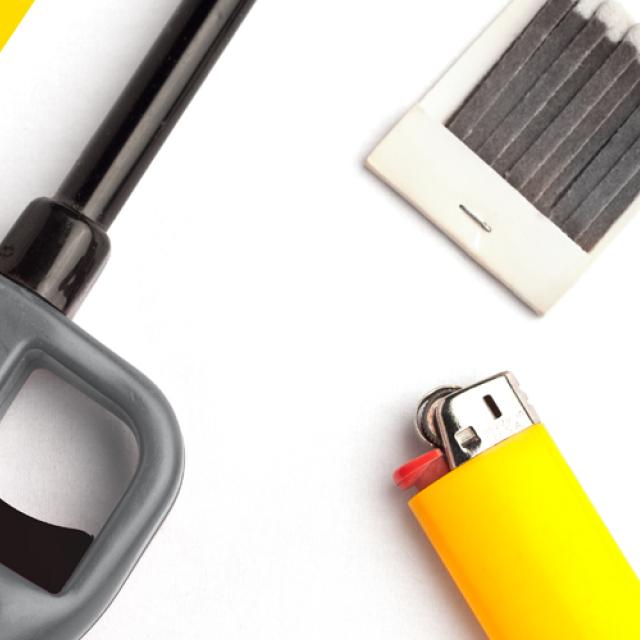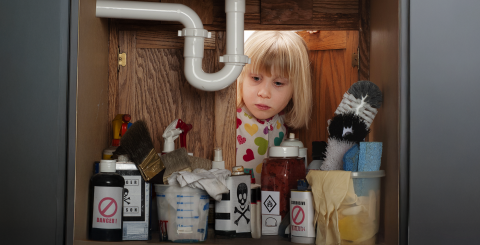Smoking Accessories: Unexpected Fire Risks

The number of smokers in Québec has been steadily declining for years. There have been several prevention campaigns to raise awareness, warn smokers of the risks, and convince them to change their habits. Not everyone will be convinced to quit. But whether you’re a regular or occasional smoker, the risks of home fires are real and are frequently caused by the deadly combination of smoking accessories and carelessness.
This section covers the danger associated with smoking accessories, high risk situations, and above all else, precautions you can take to avoid the worst.
Number of Fires Caused by Smoking Accessories in Québec
A study conducted by Ministère de la Sécurité publique revealed that the most common culprits in home fires in Québec —after cooking appliances—were candles and smoking accessories such as cigarettes, E-cigarettes, cigars, pipes, lighters, matches, tobacco boxes, and ashtrays.
In 2015 alone, no fewer than 865 fires were started by smoking-related heat sources—almost 19% of the total number of fires. The fires were surprising and devastating and in many cases were fatal for both adults and children.
Of course, smokers aren’t the only ones who are at risk. When we include matches and lighters used for candles, fireplaces, and other similar items, the number of fires increases to 1,000 per year.
Examples of High Risk Situations and Fires Caused by Smoking Accessories
Here are some of the most common causes of house fires in recent years, from getting distracted and falling asleep to carelessness and ignorance:
- Children playing with lighters, matches, ashtrays, or even some cigarettes
- Smokers falling asleep in bed with a lit cigarette in their hand
- Precariously-placed ashtrays tipping over onto a bed, armchair, couch, or the floor
- Lit cigarettes being left or forgotten on couches, chairs, or other flammable surfaces
- Cigarettes falling off of ashtrays that aren’t wide enough or don’t have a high enough lip
- Ashtrays being emptied into the garbage while the ash is still smoldering
- People smoking or stubbing out cigarettes too close to solvents or flammable products
- Cigarettes being stubbed out in flower pots, planters, or flowerbeds that contain flammable elements or parts
- Lithium batteries from E-cigarettes overheating while charging and setting fire to a combustible material—or even exploding
Tips for Reducing Fire Risks Associated with Smoking Accessories: Simple Acts That Save Lives
Watch, be careful, have the right equipment, take action, make smart decisions—there are lots of safe and easy ways to start reducing fire risks today. We’ve divided our tips below into categories for you to read over.
Watching and taking precautions
- Keep an eye on your cigarette until it is completely stubbed out. As long as a cigarette is still burning in an ashtray or on a table, couch, bed, or other flammable surface, there’s a risk of a fire.
- Never smoke near flammable items, solvents, gas sources, pipes, or explosive products such as fireworks. These things are often the cause of major fires—or even explosions.
Children
- Always keep smoking accessories out of the reach of children. If kids play with matches, lighters, cigarettes, or hot ashtrays while you aren’t looking, they could start a fire!
- Teach your children to stay away from smoking accessories. Explain to them that they should never play with smoking accessories and explain how these objects could start a fire in your home.
Ashtrays and flower pots
- Use an ashtray with high or flat wide edges, a deep can filled with wet sand, or a self-closing metal ashtray. That way your cigarette won’t fall out of the ashtray and start a fire when you aren’t looking. That being said, remember to always put out your cigarette before leaving a room.
- Place your ashtray on a stable surface, away from the edges if it’s elevated and away from flammable items such as curtains, towels, and tablecloths.
- Always wet the ashes and cigarette butts in the ashtray before emptying them into the garbage.
- Never throw your cigarette into a flower pot, planter, or flower bed because, contrary to popular belief, they contain a number of flammable elements and materials. This is a common source of fires that can sometimes ignite several hours after the cigarette was dropped or stubbed out.
Drowsiness and impaired faculties
- Never smoke in bed. Lots of people fall asleep while their cigarette is still lit and cause fires that quickly get out of control.
- Avoid smoking if you’re impaired due to drugs, fatigue, alcohol, cannabis, or medications that cause drowsiness. If you fall asleep or aren’t alert or responsive enough when you’re smoking, it could lead to the worst.
Vaping (e-cigarettes)
- Don’t overcharge the lithium battery on your E-cigarette. Many fires and even explosions have been reported since E-cigarettes hit the market.
- Always keep an eye on your E-cigarette when it’s charging. Don’t leave it plugged in while you’re sleeping or when you leave the room or house.
- Always transport your E-cigarette in its protective case. Whether you carry it in a bag, briefcase, or pocket, an overcharged or defective battery can catch fire wherever it is.
Quit smoking
- If you quit smoking for good, you can get rid of all your smoking accessories and eliminate the risk they pose to your home and loved ones. Quitting can be hard, but it has positive effects on your health and quality of life, as well as that of your loved ones.
- There are many programs, products, groups, and other solutions available to help you stop smoking for good. Talk to your doctor, pharmacist, or former smokers who have successfully quit.
Three Essential Things to Do Today to Protect Your Home From Fires
In addition to the recommendations for safely using smoking accessories, here are three essential fire protection measures. No matter what the reason, if there’s a fire, you need to be prepared to respond.
Make sure smoke alarms are fully charged and installed in key locations
- Install smoke alarms on the ceiling of each floor, including the basement, in the middle of rooms or corridors if possible.
- Don’t forget to install them in children’s and smokers’ rooms.
- Test the alarms at least two or three times a year to make sure they’re working properly.
- Replace them every ten years to avoid malfunction.
Keep a working, portable extinguisher in an easy-to-access place
- Always buy an approved extinguisher model
- Store it somewhere you can access quickly and easily, near an exit.
- Read the instruction manual so you know how to use it when the time comes.
- Only use it to extinguish a fire that has just started, not a big fire.
- Tell your children, family, friends, roommates, and anyone who visits your house regularly where the extinguisher is and how to use it.
Have an escape plan and practice it with your family
- Identify the exits that are the quickest and easiest to access in your home.
- Always make sure these exists are clear.
- Practice different escape scenarios: alone and with your family, during the day and at night, in the summer and in the winter.
- Pick a meeting point outside the home.
- Don’t forget that the risk of being overcome by smoke is just as big a risk as getting burned by flames. Getting out of the house as quickly as possible is your main priority.
Now that you know about the scope and causes of fires and have read our advice on protective measures to take, you’re better informed about the fire risks associated with smoking accessories. If you have relatives, friends, neighbours, or coworkers who may be vulnerable to these risks, talk to them or share this article with them. It’s a simple gesture that can make a huge difference.




